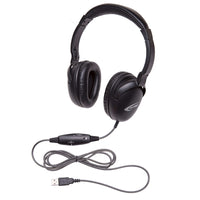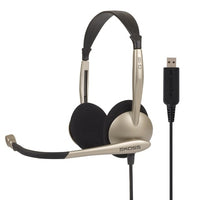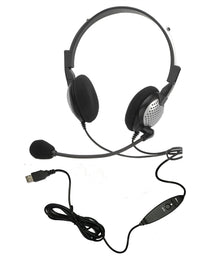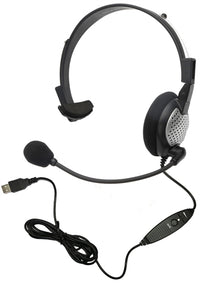USB headsets are becoming important tools in science, technology, engineering, and math (STEM) labs. They help students and teachers communicate better and work together more easily. Let's look at how these headsets are making STEM classes more fun and effective.
Key Points for USB Headsets in STEM Labs
- Better sound quality improves communication and learning
- Noise cancellation helps students focus in busy labs
- Works with many devices for easy lab setup
- Regular cleaning keeps shared headsets hygienic
- Creative use enhances STEM learning experiences
Understanding USB Headset Technology
USB headsets are special headphones with a microphone that plug into a computer's USB port. They're better than regular headphones because they have clearer sound. There are two types of USB connections:
- USB-A: The bigger, rectangle-shaped plug you might see on older computers
- USB-C: A smaller, oval-shaped plug found on newer devices
When picking USB headsets for your STEM lab, try to get ones that work with both types. This way, they'll work with different computers. USB headsets often have special features that make sound clearer, which is great for learning in labs. Check out our USB headsets to find the right ones for your lab.
Why USB Headsets are Great for STEM Labs
1. Better Sound Quality
USB headsets make it easier to hear instructions and explanations clearly. This is really important when learning about complex science or math topics. The good sound quality helps students understand better and avoid mistakes.
2. Noise Cancellation for Better Focus
STEM labs can be noisy with all the equipment and people working. Many USB headsets can block out background noise, helping students concentrate on their work or online lessons. This is especially helpful for tasks that need a lot of focus, like coding or analyzing data.
3. Works with Many Devices
USB headsets can connect to lots of different devices used in STEM labs, like computers and tablets. This means students can easily switch between different workstations without any trouble. They're simple to use - just plug them in and they're ready to go.
Look at our headsets for younger kids if you're teaching STEM to elementary school students.
Choosing the Right USB Headsets for Your STEM Lab
1. Durability
STEM labs can be tough on equipment. Look for headsets that can handle being used a lot and maybe even dropped occasionally. Headsets with strong cables and sturdy construction are good choices.
2. Comfort
Students might wear these headsets for long periods. Choose ones with soft ear pads and adjustable headbands so they're comfortable during long lab sessions or online classes.
3. Sound Quality
Clear sound is crucial for learning. Pick headsets with good speakers and microphones to ensure students can hear and be heard clearly.
Here are some good USB headsets for STEM classes:
Setting Up USB Headsets in Your STEM Lab
1. What You Need
Most modern computers work with USB headsets. Just make sure your lab computers have free USB ports and up-to-date software.
2. How to Set Them Up
- Plug the USB headset into a free USB port on the computer.
- Wait for the computer to recognize the headset.
- Go to your computer's sound settings and make sure the USB headset is selected.
- Test the headset by playing some audio and speaking into the microphone.
- Adjust the volume and microphone settings if needed.
3. Fixing Common Problems
If something's not working, try these quick fixes:
- Unplug the headset and plug it back in
- Restart the computer
- Check for any software updates
- Try a different USB port
- Make sure the headset isn't muted in the computer settings
- Test the headset on another device to see if it's working
For more help with setting up and fixing USB headsets, read our blog post about noise-canceling headphones for STEM labs.
Using USB Headsets in STEM Classes
USB headsets can make STEM classes more interesting. Here are some cool ways to use them:
1. Audio Learning Activities
Create fun lessons with audio instructions or interactive tutorials. Students can listen to explanations of science concepts or follow spoken directions for experiments.
2. Online Teamwork and Remote Learning
USB headsets are great for video calls and online classes. They help students talk clearly with each other or with experts in different STEM fields, even if they're not in the same room.
3. Making Projects and Presentations Better
Encourage students to make their own educational videos or podcasts using the good-quality microphones on USB headsets. This helps them understand STEM topics better and practice explaining things clearly.

Real Examples of USB Headsets in STEM Labs
Elementary School Example
At Sunshine Elementary, third-graders use USB headsets in their coding classes. The clear sound helps them follow along with tutorials, and the noise-canceling feature helps them focus in the busy computer lab. Teachers say students are learning to code faster since they started using the headsets.
Middle School Example
Riverdale Middle School's robotics team uses USB headsets when they're designing robots together online. The good microphones let team members share ideas clearly, even when they're working on different parts of the project. This has helped them work better as a team and come up with more creative robot designs.
High School Example
At Tech High, advanced physics students use USB headsets to join live online talks with scientists from around the world. The great sound quality lets them ask questions and talk about new scientific discoveries. This has inspired many students to want to pursue careers in science and technology.
These stories show how USB headsets can be useful for students of all ages in different STEM subjects. To learn more about how we're helping improve STEM education, check out our About Us page.
Taking Care of USB Headsets in the Lab
To keep your USB headsets working well for a long time, follow these tips:
1. Cleaning
Clean the headsets regularly with alcohol wipes, especially the ear pads and microphones. This keeps them hygienic when many students are sharing them. Teach students how to clean the headsets properly.
2. Storage
Have a special place to store each headset. Use hooks or stands to keep them off the lab tables and prevent damage. Label the headsets and assign them to specific workstations to reduce wear and tear.
3. Making Them Last Longer
Show students how to handle the headsets carefully, like not tangling the cords or pulling on the USB plug. Check the cables often for any damage and replace them if needed. Make rules for using the headsets in your lab to make sure everyone treats them with care.
What's Next for USB Headsets in STEM Education
Technology is always changing, and USB headsets for STEM classes are getting better too. Here are some cool things we might see in the future:
1. Better Noise-Cancellation
Future USB headsets might use artificial intelligence to block out noise even better, adapting to different sounds in the lab to help students focus.
2. Working with Virtual and Augmented Reality
As virtual and augmented reality become more common in STEM classes, USB headsets might change to work better with these technologies. This could make virtual lab experiments feel more real.
3. Longer Battery Life and Wireless Options
While current USB headsets need to be plugged in, future ones might have long-lasting batteries and work wirelessly. This could make it easier to move around the lab and set up different workstations.
Stay up-to-date with our newest USB-C headsets, made to keep up with the changing needs of STEM education.
Conclusion: Making the Most of USB Headsets in STEM Labs
Using USB headsets in STEM labs is a great way to make learning more engaging and effective. These headsets help students communicate better, focus more, and try new ways of learning about science, technology, engineering, and math.
We've seen how USB headsets can be useful for all kinds of students, from kids just starting to learn about coding to high school students talking with real scientists. By choosing the right headsets, taking good care of them, and using them in creative ways, teachers can really improve how students learn STEM subjects.
We encourage all STEM teachers to give USB headsets a try in their labs. They're a simple tool that can make a big difference in how students learn and enjoy STEM subjects.







